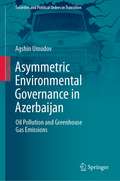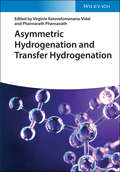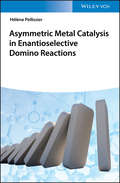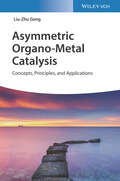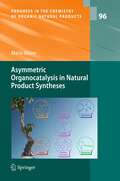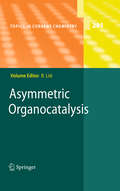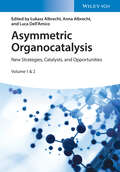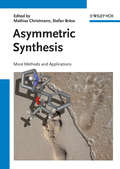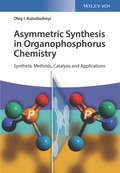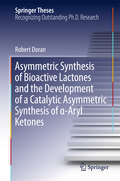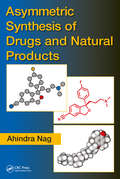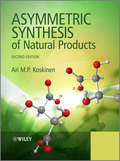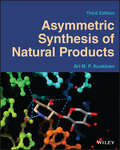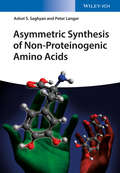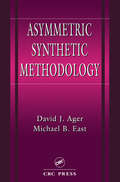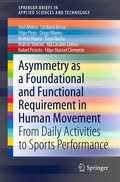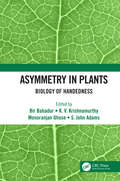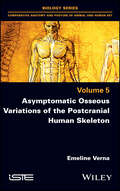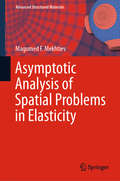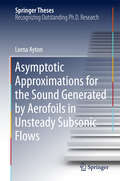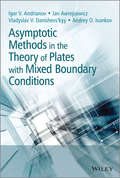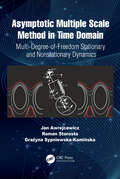- Table View
- List View
Asymmetric Environmental Governance in Azerbaijan: Oil Pollution and Greenhouse Gas Emissions (Societies and Political Orders in Transition)
by Agshin UmudovThis book examines why authoritarian governments are willing to address environmental problems that have an international impact, such as CO2 emissions, but are reluctant to address problems that have only a domestic impact. In a case study of Azerbaijani oil politics, it demonstrates how the incumbent Azerbaijani regime has taken important measures trying to address CO2 emissions while ignoring the damage caused by oil pollution on the Caspian coast. The book argues that resource-rich authoritarian governments are eager to join international environmental initiatives to improve their image, but they address domestic environmental issues mainly if they threaten their hold on power.This book is an important contribution to scholarship on environmental governance in the post-Soviet space, an area that is poorly researched. Therefore, it is a must-read for researchers and scholars interested in post-Soviet studies, as well as in the nexus between mineral-rich regions and how social policy is created, e.g., environment, education, and healthcare. In addition, this book will be of tremendous importance for policymakers and international organizations as it looks into the motivation of authoritarian states in the post-Soviet space for environmental measures.
Asymmetric Hydrogenation and Transfer Hydrogenation
by Virginie Ratovelomanana-VidalDiscover the latest developments in homogeneous asymmetric (transfer) hydrogenation with this up-to-date resource Asymmetric Hydrogenation and Transfer Hydrogenation delivers a current and cutting-edge investigation of homogenous asymmetric hydrogenation and transfer hydrogenation reactions of prochiral substrates by using organometallic catalysts (like ruthenium, rhodium, iridium, iron, and copper) and organic catalysts. Distinguished researchers and editors Virginie Ratovelomanana-Vidal and Phannarath Phansavath also offer readers a comprehensive walkthrough of substituted ketones through dynamic kinetic resolution, as well a presentation of the mechanisms and application of asymmetric hydrogenation reactions to the synthesis of biologically relevant compounds. The book comprehensively details its complex subject matter clearly and plainly and covers everything from catalyst development and reactions to mechanisms and applications in academia and industry. The papers included within come from many of the leading voices in their respective fields and represent the newest and best research available today. Compiled for researchers and private-industry chemists alike, Asymmetric Hydrogenation and Transfer Hydrogenation also discusses a wide variety of other topics like: A discussion of the development of chiral metal catalysts for asymmetric transfer hydrogenation Several examinations of asymmetric transfer hydrogenation of a variety of chemical groups, including ketones, aryl and heteroaryl ketones, substituted ketones, and heteroaromatic compounds, akenes, and imines An exploration of the mechanism of asymmetric hydrogenation and continuous flow asymmetric hydrogenation A full and thorough treatment of the industrial applications of asymmetric hydrogenation Perfect for catalytic chemists, chemists working on or with organometallics, organic chemists, natural product chemists, pharmaceutical chemists, medicinal chemists, and industrial chemists, Asymmetric Hydrogenation and Transfer Hydrogenation also belongs on the bookshelves of research and university institutes and libraries who wish to expand their selection on a topic fundamental to organic synthesis.
Asymmetric Metal Catalysis in Enantioselective Domino Reactions
by Helene PellissierIntroduces an innovative and outstanding tool for the easy synthesis of complex chiral structures in a single step Covering all of the literature since the beginning of 2006, this must-have book for chemists collects the major progress in the field of enantioselective one-, two-, and multicomponent domino reactions promoted by chiral metal catalysts. It clearly illustrates how enantioselective metal-catalyzed processes constitute outstanding tools for the development of a wide variety of fascinating one-pot asymmetric domino reactions, thereby allowing many complex products to be easily generated from simple materials in one step. The book also strictly follows the definition of domino reactions by Tietze as single-, two-, as well as multicomponent transformations. Asymmetric Metal Catalysis in Enantioselective Domino Reactions is divided into twelve chapters, dealing with enantioselective copper-, palladium-, rhodium-, scandium-, silver-, nickel-, gold-, magnesium-, cobalt-, zinc-, yttrium and ytterbium-, and other metal-catalyzed domino reactions. Most of the chapters are divided into two parts dealing successively with one- and two-component domino reactions, and three-component processes. Each part is subdivided according to the nature of domino reactions. Each chapter of the book includes selected applications of synthetic methodologies to prepare natural and biologically active products. -Presents the novel combination of asymmetric metal catalysis with the concept of fascinating domino reactions, which allows high molecular complexity with a remarkable level of enantioselectivity -Showcases an incredible tool synthesizing complex and diverse chiral structures in a single reaction step -Includes applications in total synthesis of natural products and biologically active compounds -Written by a renowned international specialist in the field -Stimulates the design of novel asymmetric domino reactions and their use in the synthesis of natural products, pharmaceuticals, agrochemicals, and materials Asymmetric Metal Catalysis in Enantioselective Domino Reactions will be of high interest to synthetic, organic, medicinal, and catalytic chemists in academia and R&D departments.
Asymmetric Organo-Metal Catalysis: Concepts, Principles, and Applications
by Liu-Zhu GongExplore the latest advances involving organo/metal combined catalysts from leading contributors in the field In Asymmetric Organo-Metal Catalysis: Concepts, Principles, and Applications, accomplished chemist Liu-Zhu Gong delivers a comprehensive discussion of how to design efficient organo/metal combined catalyst systems, new cooperatively catalyzed asymmetric reactions, relay catalytic cascades, and multicomponent reactions. The distinguished author covers critical topics, like the combined catalysis of chiral phase transfer catalysts, enamine, iminium, nucleophilic Lewis base, or Bronsted acids with metal complexes, while also covering the cooperative catalysis of photocatalysts and organocatalysts. The book offers readers an exploration of the general concepts and principles of bond activation and reorganization, together with a comprehensive introduction to the historical developments and recent advances in the field. Readers will also benefit from the descriptions of new chemistry and new synthetic methods included within. Asymmetric Organo-Metal Catalysis also provides: Thorough introductions to chiral PTC-metal cooperative catalysis and enamine-metal cooperative catalysis Comprehensive explorations of iminum-metal relay catalysis and cooperative catalysis of bronsted acids and transition metals Practical discussions of metal-bronsted acid relay catalysis and Lewis base–Lewis acid cooperative catalysis In-depth examinations of Lewis base-transition metal cooperative catalysis and photocatalysis combined with organocatalysis Perfect for organic, catalytic, and pharmaceutical chemists, Asymmetric Organo-Metal Catalysis: Concepts, Principles, and Applications is also an invaluable resource for chemists working with or on organometallics.
Asymmetric Organocatalysis in Natural Product Syntheses (Progress in the Chemistry of Organic Natural Products #96)
by Mario WaserThis book provides the reader with an illustrative overview concerning successful and widely used applications of organocatalysis in the field of natural product synthesis. The main focus will be on organocatalytic key-steps for each (multi-step) synthesis described, whereas other often particularly innovative transformations will be omitted, as this would be beyond the scope of this volume.
Asymmetric Organocatalysis: Lewis Base And Acid Catalysts (Topics in Current Chemistry #291)
by Benjamin ListKerstin Etzenbach-Effers, Albrecht Berkessel: Non-Covalent Organocatalysis Based on Hydrogen Bonding: Elucidation of Reaction Paths by Computational Methods. - Petri M. Pihko, Inkeri Majander, and Anniina Erkkilä: Enamine Catalysis. - Jennifer L. Moore, Tomislav Rovis: Lewis Base Catalysts 6: Carbene Catalysts. - Amal Ting, Jennifer M. Goss, Nolan T. McDougal, and Scott E. Schaus: Brønsted Base Catalysts. - O. Andrea Wong, Yian Shi: Chiral Ketone and Iminium Catalysts for Olefin Epoxidation. - Alan C. Spivey, Stellios Arseniyadis: Amine, Alcohol and Phosphine Catalysts for Acyl Transfer Reactions. - John B. Brazier, Nicholas C. O. Tomkinson: Lewis Base Catalysts 2 Secondary and Primary Amine Catalysts for Iminium Catalysis. - Oksana Sereda, Sobia Tabassum, and René Wilhelm: Lewis Acid Organocatalysts. - Daniela Kampen, Corinna M. Reisinger, and Benjamin List: Chiral Bronsted Acids for C Organocatalysis.
Asymmetric Organocatalysis: New Strategies, Catalysts, and Opportunities, 2 Volumes
by Lukasz AlbrechtAsymmetric Organocatalysis Comprehensive resource on the latest and most important developments in the highly vivid field of asymmetric organocatalysis The book provides a comprehensive overview of the most important advancements in the field of asymmetric organocatalysis that have occurred within the last decade. It presents valuable examples of newly developed synthetic methodologies based on various organocatalytic activation modes. Special emphasis is given to strategies where organocatalysis is expanding its potential by pushing the boundaries and founding new synergistic interactions with other fields of synthetic chemistry, such as metal catalysis, photocatalysis, and biocatalysis. The application of different concepts (such as vinylogy, dearomatization, or cascade reactivity), resulting in the development of new functionalization strategies, is also discussed. Sample topics covered within the book include: New developments in enantioselective Brønsted acid catalysis with strong hydrogen-bond donors Asymmetric phase-transfer catalysis, from classical applications to new concepts Halogen-bonding organocatalysis Asymmetric electrochemical organocatalysis and synergistic organo-organocatalysis Immobilized organocatalysts for enantioselective continuous flow processes Mechanochemistry and high-pressure techniques in asymmetric organocatalysis Useful tools in elucidation of organocatalytic reaction mechanisms With an overall focus on new reactions and catalysts, this two-volume work is an indispensable source for everyone working in the field of asymmetric organocatalysis.
Asymmetric Synthesis II
by Stefan Bräse Mathias ChristmannAfter the overwhelming success of 'Asymmetric Synthesis - The Essentials', narrating the colorful history of asymmetric synthesis, thisis the second edition with latest subjects and authors. While the aim of the first edition was mainly to honor the achievements of the pioneersin asymmetric syntheses, the aim of this new edition was bringing the current developments, especially from younger colleagues, to theattention of students. The format of the book remained unchanged, i.e. short conceptual overviews by young leaders in their field includinga short biography of the authors. The growing multidisciplinary research within chemistry is reflected in the selection of topics including metal catalysis, organocatalysis, physical organic chemistry, analytical chemistry, and its applications in total synthesis. The prospective reader of this book is a graduate or undergraduate student of advanced organic chemistry as well as the industrial chemist who wants to get a brief update on the current developments in the field.
Asymmetric Synthesis in Organophosphorus Chemistry: Synthetic Methods, Catalysis and Applications
by Oleg I. KolodiazhnyiAuthored by one of the leading experts in the field, this is the only comprehensive overview of chiral organophosphorus compounds, from asymmetric synthesis to catalysis and pharmacological applications. As such, this unique reference covers the chemical background as well as spectroscopical analysis of phosphorus compounds, and thoroughly describes all the various synthetic strategies for these substances. Metal-, organo- and biocatalyzed reactions for the introduction of phosphorus are explained as are asymmetric oxidation and reduction methods for the preparation of all possible oxidation states of phosphorus. The text also includes industrial applications for these compounds. Of particular interest to chemists working in the field of asymmetric synthesis, as well as to the pharmaceutical industry due to the increasing number of phosphorous-containing drugs.
Asymmetric Synthesis of Bioactive Lactones and the Development of a Catalytic Asymmetric Synthesis of α-Aryl Ketones (Springer Theses)
by Robert DoranThis thesis addresses two fundamental areas in contemporary organic chemistry: synthesis of natural products and catalytic asymmetric synthesis. Firstly, a new methodology, developed by our research group, which allows the asymmetric synthesis of lactones, a structural unit ubiquitous in natural products, was utilised in the synthesis of a number of natural product analogues that showed significant biological activity. Secondly, the development of a catalytic asymmetric synthesis of a key structural motif present in a number of natural products and pharmaceuticals was accomplished. During the course of this work we discovered dual stereo control, which is significant because it allows the configuration of a new stereo centre to be controlled by a simple change of proton source.
Asymmetric Synthesis of Drugs and Natural Products
by Ahindra NagThis book focuses on different techniques of asymmetric synthesis of important compounds, such as drugs and natural products. It gives insightful information on recent asymmetric synthesis by Inorganic, Organic and Enzymatic combinations. It also emphasizes chiral compounds and design of new catalyst for synthesis of compounds.
Asymmetric Synthesis of Natural Products
by Ari M. KoskinenAsymmetric Synthesis of Natural Products, 2nd Edition introduces students to this rapidly growing field of organic chemistry. The initial chapters present the foundations of asymmetric synthesis, including the theory and applications of individual asymmetric reactions. This is followed by chapters on each of the major individual classes of natural products; their structures, biosynthesis and interrelationships as well as examples of asymmetric syntheses and the practical value of these compounds. Natural product classes covered include carbohydrates, amino acids, peptides, proteins, nucleosides, nucleotides, nucleic acids, polyketides, isoprenoids, shikamic acid derivatives and alkaloids.For this second edition the text has been thoroughly updated and expanded, and includes new discussions and examples covering atom and redox economies, practical aspects and environmental awareness. Organocatalysis has emerged completely in the last ten years, and has been fully integrated into this new edition.
Asymmetric Synthesis of Natural Products
by Ari M. KoskinenAsymmetric Synthesis of Natural Products Fully updated learning resource covering the concept of using natural product chemistry for strategies in asymmetric synthesis The third edition of Asymmetric Synthesis of Natural Products introduces students to the rapidly growing field of natural products in organic chemistry, discussing the practical, mainly pharmacological, importance of selected compounds and emphasizing the target-oriented approach of organic synthesis which is key in industrial strategies. To aid in reader comprehension, the text includes key references and an Index of Compounds. The textbook is based on two lecture courses (Asymmetric Synthesis & Asymmetric Synthesis of Natural Products), which the author has delivered more than 50 times over the past 20 years in Finland, the UK, Italy, and Greece. This third edition is fully updated from the earlier versions (published by Wiley in 1993 and 2012). The importance of natural products as truly renewable raw materials in sustainable chemistry and circular economy is illustrated through applications of e.g. organocatalysis, organometallic catalysis, and biocatalysis. The contents consist of traditional text supplemented with illustrations (such as chemical drawings and structural formulae). Three dimensional aspects are also discussed with the use of 3D renderings of structures for both reaction mechanisms (molecular modeling) and crystallographic data. Sample topics covered in the textbook include: The foundations of asymmetric synthesis, including the theory and applications of individual asymmetric reactions Sustainable development, the circular economy, and use of renewable raw materials that have become prominent in many fields of science and technology Various natural product classes, including carbohydrates, amino acids, peptides, proteins, nucleosides, nucleotides, nucleic acids, and polyketides The properties of these natural product classes, including their structures, biosynthesis, and interrelationships, as well as examples of asymmetric syntheses and the practical value of these compounds Asymmetric Synthesis of Natural Products is a comprehensive, authoritative, and up-to-date learning resource on the subject for advanced level undergraduate or early-stage graduate students. It is also useful for specialists already working in synthesis who wish to learn about asymmetric synthesis.
Asymmetric Synthesis of Non-Proteinogenic Amino Acids
by Peter Langer Ashot S. SaghyanAuthored by two internationally recognized experts with an excellent track record, this much-needed reference summarizes latest research in the rapidly developing field of stereoselective synthesis of enantiomerically enriched amino acids, particularly of non-proteinogenic origin. It highlights several different catalytic and stoichiometric asymmetric methods for their synthesis and also provides information on origin, biological properties, different synthetic strategies and important applications in medicine and pharmacology. Essential reading for synthetic chemists working in the field of asymmetric synthesis, natural products and peptide synthesis, stereochemistry, medicinal chemistry, biochemistry, pharmacology, and biotechnology.
Asymmetric Synthesis of Three-Membered Rings
by Alessandra Lattanzi Hélène Pellissier Renato DalpozzoThe first handbook to focus on the asymmetric synthesis of different types of three-membered rings. The outstanding and experienced authors have an excellent international reputation and cover cyclopropanes, epoxides and aziridines as well as chiral oxaziridines in equal measure. To this end, they describe in detail different synthetic approaches starting with chiral substrates as well as the application of chiral metal- or organocatalysts. Furthermore, methods for the kinetic resolution of initially racemic products are treated alongside recent advances and novel developments in established techniques for the synthesis of three-membered rings. With its structured composition this is of high interest to scientists in methodological and natural product synthesis as well as those in industrial and pharmaceutical chemistry.
Asymmetric Synthetic Methodology
by David John Ager Michael B. EastThis comprehensive text presents a critical discussion of the scopes and limitations of various organic synthetic methodologies that are available for performing asymmetric transformations. In addition to purely chemical methods, the book covers applications of new enzymes and other biological systems that are increasingly useful in asymmetric methodology.
Asymmetry as a Foundational and Functional Requirement in Human Movement: From Daily Activities to Sports Performance (SpringerBriefs in Applied Sciences and Technology)
by Filipe Manuel Clemente José Afonso Cristiana Bessa Filipe Pinto Diogo Ribeiro Beatriz Moura Tiago Rocha Marcus Vinícius Rui Canário-Lemos Rafael PeixotoThis book describes the structural and functional asymmetries in human body movement by providing cases and examples using illustrations and easy-to-understand scenarios. Specifically, it adopts an evidence-based approach to demonstrate (i) the role of structural (e.g., bone dimensions) and functional (e.g., hemispheric dominance) asymmetries in the human body; (ii) the asymmetric nature of most daily activities (e.g., gait, mastication); (iii) the benefits of asymmetry for physical performance; and (iv) the role of asymmetry in preventing injury. More than just a scientific book, it bridges the gap between theory and practice, and includes practical examples and applications. The book appeals to academics and practitioners in the fields of kinesiology, human movement, sports sciences, strength and conditioning, and physiotherapy.
Asymmetry in Plants: Biology of Handedness
by Bir Bahadur K. V. Krishnamurthy Monoranjan Ghose S. John AdamsPlants exhibit forms of asymmetry analogous to "handedness" in bilaterally symmetrical animals. This book explores the evolutionary significance and development of asymmetry. Examples of genetic control include the direction of tendril or stem coiling of many climbing plants; the so-called spiral phyllotaxy and floral taxy; and contorted petal arrangement is another kind of left- right symmetry in plants; the direction of contortion is fixed in some but not in other plants. The book will underscore tha all phenomena related to handedness start during embryogenesis itself, with the occurrence of embryo rotation. Key selling features: First consolidated book on Plant Handedness Relates handedness, asymmetry and chirality to the evolution of different organizational levels in plant biology Emphasizes handedness as a vital governing force in plant functional evolution Provides a new perspective, hitherto ignored, into plant developemtn and evolution Describes how an age-old phenomenon can give scope for investigation from a very modern interdisciplinary approach
Asymptomatic Osseous Variations of the Postcranial Human Skeleton
by Emeline VernaSince ancient times, asymptomatic bone variations have been studied in many different disciplines. In radiology, for example, they enable the differentiation of the typical from the anomalous, but in biological anthropology they are especially useful in answering questions about humans and their diachronic and synchronic variability. This book provides an easily accessible presentation of the osseous variations of the postcranial skeleton (from the spine to the feet), which are sometimes poorly understood by the scientific community. These variations are examined one by one, with definitions, population frequencies and complete illustrations given for each. Asymptomatic Osseous Variations of the Postcranial Human Skeleton is intended as a comprehensive reference manual for further research on these types of skeletal variations.
Asymptotic Analysis in General Relativity
by Thierry Daudé Dietrich Häfner Jean-Philippe NicolasThis volume compiles notes from four mini courses given at the summer school on asymptotic analysis in general relativity, held at the Institut Fourier in Grenoble, France. It contains an up-to-date panorama of modern techniques in the asymptotic analysis of classical and quantum fields in general relativity. Accessible to graduate students, these notes gather results that were not previously available in textbooks or monographs and will be of wider interest to researchers in general relativity. The topics of these mini courses are: the geometry of black hole spacetimes; an introduction to quantum field theory on curved spacetimes; conformal geometry and tractor calculus; and microlocal analysis for wave propagation.
Asymptotic Analysis of Spatial Problems in Elasticity (Advanced Structured Materials #99)
by Magomed F. MekhtievThe book presents homogeneous solutions in static and dynamical problems of anisotropic theory of elasticity, which are constructed for a hollow cylinder. It also offers an asymptotic process for finding frequencies of natural vibrations of a hollow cylinder, and establishes a qualitative study of several applied theories of the boundaries of applicability.Further the authors develop a general theory for a transversally isotropic spherical shell, which includes methods for constructing inhomogeneous and homogeneous solutions that allow the characteristic features of the stress–strain state of an anisotropic spherical shell to be revealed. Lastly, the book introduces an asymptotic method for integrating the equations of anisotropic theory of elasticity in variable thickness plates and shells. Based on the results of the author and researchers at Baku State University and the Institute of Mathematics and Mechanics, ANAS, the book is intended for specialists in the field of theory of elasticity, theory of plates and shells, and applied mathematics.
Asymptotic Approximations for the Sound Generated by Aerofoils in Unsteady Subsonic Flows (Springer Theses)
by Lorna AytonThis thesis investigates the sound generated by solid bodies in steady subsonic flows with unsteady perturbations, as is typically used when determining the noise generated by turbulent interactions. The focus is predominantly on modelling the sound generated by blades within an aircraft engine, and the solutions are presented as asymptotic approximations. Key analytical techniques, such as the Wiener-Hopf method, and the matched asymptotic expansion method are clearly detailed. The results allow for the effect of variations in the steady flow or blade shape on the noise generated to be analysed much faster than when solving the problem numerically or considering it experimentally.
Asymptotic Diffraction Theory and Nuclear Scattering
by Roy J. Glauber Per OslandScattering theory provides a framework for understanding the scattering of waves and particles. This book presents a simple physical picture of diffractive nuclear scattering in terms of semi-classical trajectories, illustrated throughout with examples and case studies. Trajectories in a complex impact parameter plane are discussed, and it stresses the importance of the analytical properties of the phase shift function in this complex impact plane in the asymptotic limit. Several new rainbow phenomena are also discussed and illustrated. Written by Nobel Prize winner Roy J. Glauber, and Per Osland, an expert in the field of particle physics, the book illustrates the transition from quantum to classical scattering, and provides a valuable resource for researchers using scattering theory in nuclear, particle, atomic and molecular physics.
Asymptotic Methods in the Theory of Plates with Mixed Boundary Conditions
by Jan Awrejcewicz Igor Andrianov Andrey Ivankov Vladyslav Danishevs'kyyAsymptotic Methods in the Theory of Plates with Mixed Boundary Conditions comprehensively covers the theoretical background of asymptotic approaches and their use in solving mechanical engineering-oriented problems of structural members, primarily plates (statics and dynamics) with mixed boundary conditions. The first part of this book introduces the theory and application of asymptotic methods and includes a series of approaches that have been omitted or not rigorously treated in the existing literature. These lesser known approaches include the method of summation and construction of the asymptotically equivalent functions, methods of small and large delta, and the homotopy perturbations method. The second part of the book contains original results devoted to the solution of the mixed problems of the theory of plates, including statics, dynamics and stability of the studied objects. In addition, the applicability of the approaches presented to other related linear or nonlinear problems is addressed. Key features: • Includes analytical solving of mixed boundary value problems • Introduces modern asymptotic and summation procedures • Presents asymptotic approaches for nonlinear dynamics of rods, beams and plates • Covers statics, dynamics and stability of plates with mixed boundary conditions • Explains links between the Adomian and homotopy perturbation approaches Asymptotic Methods in the Theory of Plates with Mixed Boundary Conditions is a comprehensive reference for researchers and practitioners working in the field of Mechanics of Solids and Mechanical Engineering, and is also a valuable resource for graduate and postgraduate students from Civil and Mechanical Engineering.
Asymptotic Multiple Scale Method in Time Domain: Multi-Degree-of-Freedom Stationary and Nonstationary Dynamics
by Jan Awrejcewicz Roman Starosta Grażyna Sypniewska-KamińskaThis book offers up novel research which uses analytical approaches to explore nonlinear features exhibited by various dynamic processes. Relevant to disciplines across engineering and physics, the asymptotic method combined with the multiple scale method is shown to be an efficient and intuitive way to approach mechanics. Beginning with new material on the development of cutting-edge asymptotic methods and multiple scale methods, the book introduces this method in time domain and provides examples of vibrations of systems. Clearly written throughout, it uses innovative graphics to exemplify complex concepts such as nonlinear stationary and nonstationary processes, various resonances and jump pull-in phenomena. It also demonstrates the simplification of problems through using mathematical modelling, by employing the use of limiting phase trajectories to quantify nonlinear phenomena. Particularly relevant to structural mechanics, in rods, cables, beams, plates and shells, as well as mechanical objects commonly found in everyday devices such as mobile phones and cameras, the book shows how each system is modelled, and how it behaves under various conditions. It will be of interest to engineers and professionals in mechanical engineering and structural engineering, alongside those interested in vibrations and dynamics. It will also be useful to those studying engineering maths and physics.
